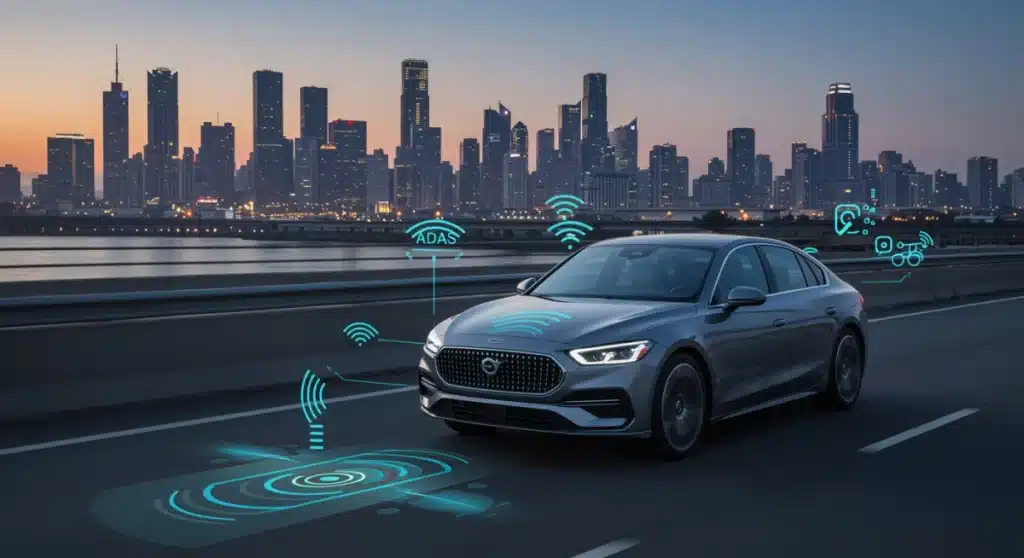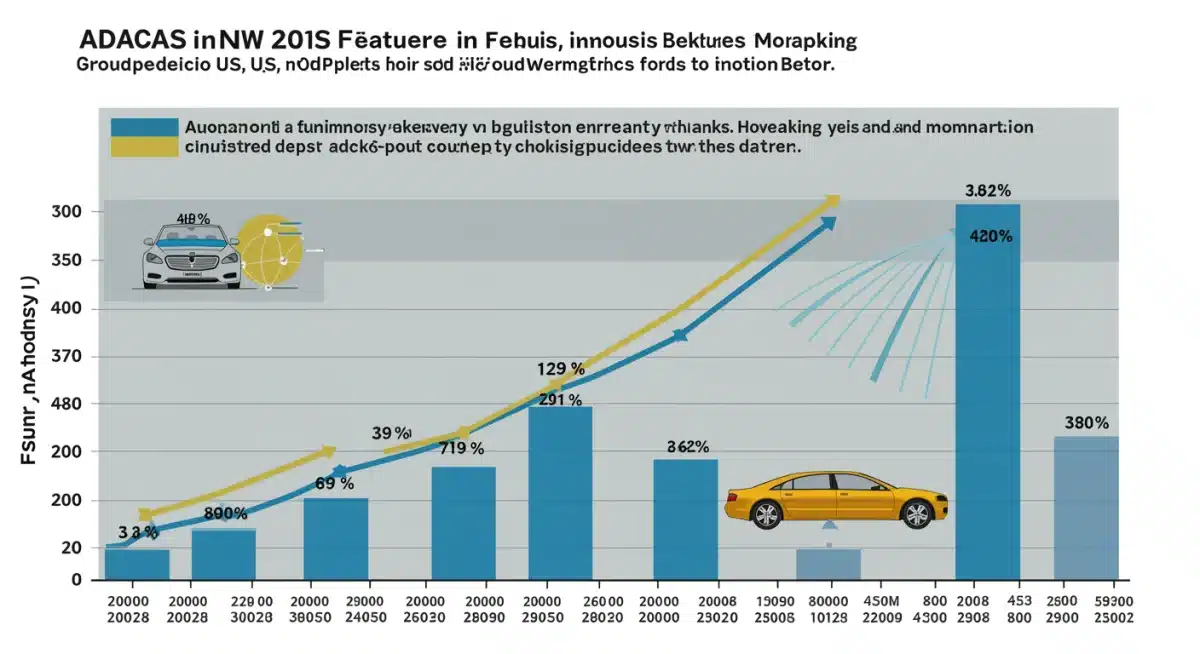ADAS in 2025: US Market Adoption and Future Growth Explored

The US market for Advanced Driver-Assistance Systems (ADAS) is experiencing significant adoption in 2025, driven by safety innovations and evolving consumer expectations, with substantial future growth projected across various vehicle segments.
As of early 2025, the automotive landscape is witnessing an undeniable surge in the integration and acceptance of Advanced Driver-Assistance Systems (ADAS) in 2025: A Deep Dive into US Market Adoption Rates and Future Growth. These sophisticated technologies are rapidly transforming how Americans drive, promising enhanced safety and convenience on our roads.
The Current State of ADAS Adoption in the US
The US market for Advanced Driver-Assistance Systems (ADAS) is demonstrating robust growth, with a clear trend towards standard integration across new vehicle models. This widespread adoption reflects both consumer demand for enhanced safety features and regulatory pushes to mitigate accidents.
Manufacturers are increasingly equipping even entry-level vehicles with foundational ADAS technologies. This strategic move aims to democratize access to safety innovations, making them less of a premium add-on and more of an expected component of modern vehicles. The market is shifting from optional extras to essential safety packages, influencing purchasing decisions significantly.
Key Technologies Driving Adoption
Several ADAS technologies are at the forefront of this adoption wave due to their immediate and tangible benefits. These systems are proving their worth in daily driving scenarios, from urban commutes to long-distance highway travel.
- Automatic Emergency Braking (AEB): Now standard on many new cars, AEB dramatically reduces rear-end collisions.
- Lane Keeping Assist (LKA) and Lane Departure Warning (LDW): These systems help drivers maintain their lane, preventing unintentional drifts.
- Blind-Spot Monitoring (BSM): Provides crucial warnings about vehicles in blind spots, enhancing situational awareness.
- Adaptive Cruise Control (ACC): Automatically adjusts vehicle speed to maintain a safe distance from the car ahead, reducing driver fatigue.
These core functionalities are becoming prerequisites for many buyers, influencing vehicle design and marketing strategies across the industry.
Regulatory Impact and Safety Mandates
Government regulations and industry safety standards play a pivotal role in accelerating ADAS adoption within the US market. These mandates ensure a baseline level of safety technology in new vehicles, pushing manufacturers to innovate and integrate more advanced systems.
The National Highway Traffic Safety Administration (NHTSA) continues to advocate for and implement new safety standards, often focusing on ADAS features that have a proven track record in reducing accidents and fatalities. These regulatory pressures are a significant driver behind the pervasive integration of these systems.
Federal and State Initiatives
Both federal and state governments are actively involved in promoting ADAS technologies through various initiatives. These range from public awareness campaigns to direct legislative actions that mandate certain features.
- NHTSA’s 5-Star Safety Ratings: Vehicles with advanced ADAS features often receive higher safety ratings, influencing consumer choice.
- Voluntary Commitments: Automakers have made voluntary commitments to make AEB standard on nearly all new passenger vehicles by 2022, a commitment largely met and now expanding to other features.
- Insurance Incentives: Many insurance providers offer discounts for vehicles equipped with certain ADAS, further incentivizing adoption.
These combined efforts create a favorable environment for the continuous integration and acceptance of ADAS, solidifying their presence in the US automotive landscape.
Consumer Perception and Acceptance
Consumer perception and acceptance are paramount for the successful integration of ADAS technologies. As of 2025, there is a growing understanding and appreciation among American drivers for the safety benefits and convenience offered by these systems, although some skepticism persists.
Initial hesitations surrounding the reliability and intrusiveness of ADAS are steadily declining as drivers experience the tangible advantages firsthand. Positive word-of-mouth and effective demonstrations by dealerships are instrumental in building confidence and fostering greater acceptance.
Overcoming Early Challenges
Early ADAS implementations sometimes faced criticism for being overly sensitive or poorly calibrated. However, continuous improvements in sensor technology, software algorithms, and user interfaces have significantly enhanced the user experience.
- Improved Reliability: Newer systems are more accurate and less prone to false alarms, increasing driver trust.
- Enhanced User Interface: Clearer alerts and intuitive controls make ADAS easier to understand and operate.
- Educational Campaigns: Manufacturers and safety organizations are investing in educating the public about ADAS functionalities and limitations.
This evolution has been crucial in shifting public opinion from cautious skepticism to widespread acceptance, paving the way for more advanced features.
Technological Advancements and Future Innovations
The pace of technological advancement in the ADAS sector remains incredibly rapid, with significant innovations continually emerging. These developments are not only refining existing systems but also paving the way for entirely new functionalities that promise even greater levels of safety and autonomy.
Researchers and engineers are focusing on improving sensor fusion, artificial intelligence, and machine learning capabilities to create more robust and predictive ADAS. This ongoing evolution is critical for the transition towards higher levels of automated driving.
Next-Generation ADAS Features
Beyond the current suite of widely adopted systems, several next-generation ADAS features are on the horizon or already in their nascent stages of deployment. These innovations aim to address more complex driving scenarios and further reduce human error.
- Driver Monitoring Systems (DMS): Using cameras to track driver attention and fatigue, issuing warnings if distraction is detected.
- Advanced Parking Assist: Systems that can autonomously park vehicles in increasingly challenging spaces.
- Intersection Assist: Technologies that help prevent collisions at intersections by monitoring cross-traffic.
- V2X Communication (Vehicle-to-Everything): Enabling vehicles to communicate with each other, road infrastructure, and pedestrians to anticipate hazards.
These future innovations will undoubtedly reshape the driving experience and further solidify the role of ADAS in preventing accidents.

The integration of these advanced capabilities underscores a future where vehicles are not just transportation devices but intelligent partners in ensuring road safety. The US market is set to embrace these innovations with open arms, given the clear benefits they offer.
Economic Implications and Market Growth Projections
The burgeoning adoption of ADAS in the US market carries substantial economic implications, driving growth across various sectors. From automotive manufacturing to software development and insurance, the ripple effects are significant and far-reaching.
Market analysts project a sustained upward trajectory for ADAS technologies, fueled by ongoing innovation, regulatory support, and increasing consumer demand. This growth translates into new job opportunities, increased investment in R&D, and a more dynamic automotive ecosystem.
Investment and Revenue Streams
The ADAS market is attracting considerable investment from both established automotive players and emerging technology companies. This influx of capital is accelerating research and development, leading to more sophisticated and cost-effective solutions.
- Increased Sales: Higher adoption rates directly translate to increased revenue for automakers and component suppliers.
- Aftermarket Opportunities: A growing market for aftermarket ADAS installations and upgrades.
- Data Monetization: The data generated by ADAS can be leveraged for traffic management, urban planning, and insurance risk assessment.
These economic drivers ensure that ADAS remains a high-priority area for investment and development, securing its future growth.
Challenges and Roadblocks to Widespread Adoption
Despite the optimistic outlook, the path to universal ADAS adoption is not without its challenges. Several roadblocks need to be addressed to ensure equitable access, seamless integration, and continued public trust in these evolving technologies.
Issues such as the cost of advanced systems, the complexity of repairs, and the need for standardized testing protocols represent significant hurdles. Overcoming these will require collaborative efforts across the industry, government, and consumer advocacy groups.
Key Obstacles to Address
Addressing these challenges is critical for maintaining momentum in ADAS adoption. Effective solutions will require innovative approaches and broad consensus.
- Cost Barriers: Advanced ADAS features can significantly increase vehicle prices, making them inaccessible to some consumers.
- Repair and Maintenance: Specialized training and equipment are needed for repairing ADAS-equipped vehicles, impacting repair costs and availability.
- Cybersecurity Concerns: As cars become more connected, the risk of cyber threats to ADAS systems increases, requiring robust security measures.
- Standardization and Interoperability: A lack of universal standards can lead to inconsistencies in system performance and user experience across different manufacturers.
- Public Education: Continued efforts are needed to educate drivers about the proper use and limitations of ADAS to prevent misuse or over-reliance.
Successfully navigating these challenges will be crucial for the long-term success and widespread integration of Advanced Driver-Assistance Systems (ADAS) in 2025: A Deep Dive into US Market Adoption Rates and Future Growth, ultimately enhancing road safety for everyone.
| Key Point | Brief Description |
|---|---|
| High Adoption Rates | Many foundational ADAS features are now standard in new US vehicles due to evolving consumer demand and regulatory pushes. |
| Regulatory Influence | Government mandates and safety ratings significantly accelerate the integration of ADAS technologies across the market. |
| Economic Growth | The ADAS market is a major economic driver, fostering investment, job creation, and new revenue streams. |
| Overcoming Challenges | Addressing cost, repair complexity, and cybersecurity is crucial for continued widespread ADAS adoption. |
Frequently Asked Questions About ADAS in 2025
In 2025, Automatic Emergency Braking (AEB), Lane Keeping Assist (LKA), Blind-Spot Monitoring (BSM), and Adaptive Cruise Control (ACC) are among the most widely adopted ADAS features. Many are now standard on new vehicle models, reflecting a strong emphasis on foundational safety systems.
Government regulations, particularly from NHTSA, significantly influence ADAS adoption by setting safety standards and promoting features like AEB. These mandates and the inclusion of ADAS in safety ratings encourage automakers to integrate these technologies, driving overall market growth.
Consumer perception of ADAS in 2025 is largely positive, with growing recognition of their safety and convenience benefits. Initial skepticism has diminished due to technological improvements, better user interfaces, and increased public education on system functionalities and limitations.
Future ADAS innovations include advanced Driver Monitoring Systems (DMS) for fatigue detection, enhanced Intersection Assist to prevent collisions, and broader Vehicle-to-Everything (V2X) communication. These advancements aim to address more complex driving scenarios and further reduce human error.
Key challenges for widespread ADAS adoption include the high cost of advanced systems, the complexity and expense of repairs, cybersecurity risks, and the need for greater standardization across manufacturers. Addressing these issues is crucial for continued market growth and consumer trust.
Looking Ahead: The Evolving Landscape of ADAS
The trajectory for Advanced Driver-Assistance Systems (ADAS) in 2025: A Deep Dive into US Market Adoption Rates and Future Growth points towards an increasingly intelligent and safer automotive future. What happens next involves not just incremental improvements, but a fundamental shift in how vehicles interact with their environment and occupants. We anticipate further legislative action aligning with technological capabilities, continuing to push the envelope for mandatory safety features. Watch for deeper integration of AI, leading to more predictive and proactive systems that anticipate hazards even before they fully materialize. The push towards seamless vehicle-to-infrastructure (V2I) communication will also gain traction, promising a more connected and collision-free road network. The industry will continue to grapple with the delicate balance between innovation, cost, and consumer readiness, but the path forward is clearly defined by enhanced safety and smarter driving experiences.





